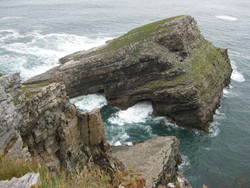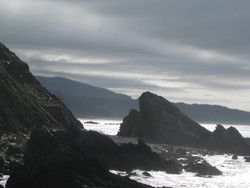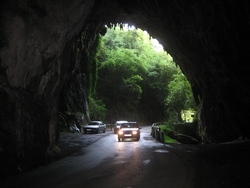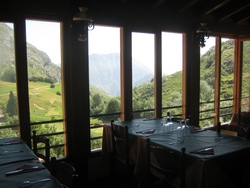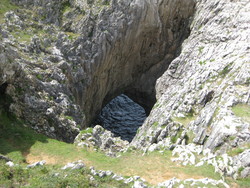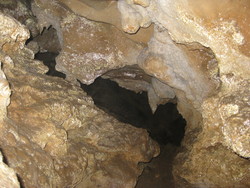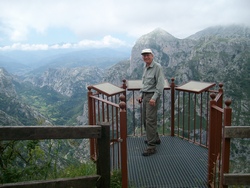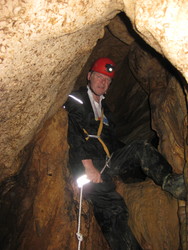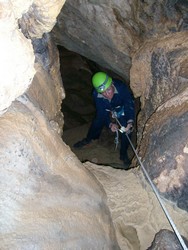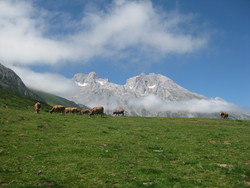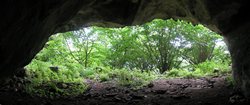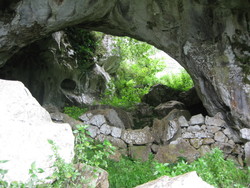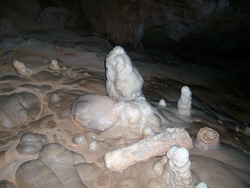

Introduction
Site list (GPS fixes) Walks (GPS tracks) Video clips Panoramas
Electronic projects:
Bat detector
Lamp tests
µ-controlled lamp
SEPIC-based lamp
ISP isolators
Making SMT boards
Expedition logs:
Spain 1973, 1974,
1975, 1976, 1977,
1979, 1982, 1983,
1985, 1986, 1987,
1988, 1989, 2000,
2001, 2002, 2003,
2004, 2005, 2006,
2007, 2008, 2009,
2010, 2011, 2012,
2013, 2014, 2015,
2016, 2017, 2018,
2019, 2020, 2021,
2022, 2023
Mexico
New England
Translation:
Expedition log, Summer 2010
Cudillero, Bufones×2, Tresviso, Nacimiento de Río Purón, Cofría, Cueva del Arco.
| Date | Activity | |||||||||||||||||||
|---|---|---|---|---|---|---|---|---|---|---|---|---|---|---|---|---|---|---|---|---|
| 04.07 | On time trip for Mike from Stansted, arriving Asturias (OVD) at 16:20, found hotel in Cudillero, a fishing village 15km west of the airport. | |||||||||||||||||||
| 05.07 | West along coast road; hikes at Cabo Vidio and around the lighthouse at Cabo Busto, then a slow lunch in Luarca (interesting little fishing town, similar to Llanes except no limestone). Back using A8 as far as possible; amazing viaducts across deep valleys. Then to San Esteban at the mouth of the Nalón and a walk out to the end of the huge and long breakwater. | |||||||||||||||||||
| 06.07 | Inland loop; across the Nalón then south to Gardo to look for maps. Then AS15 towards Cangas del Narcea alongside long thin lakes before heading north to Tíneo for lunch. Back towards Pravia via La Espina – limestone spotted below a windfarm, but huge roadworks made it impractical to approach. North of Pravia and just north of Los Cabos there is a very nice 360° viewpoint of the coastal plateau and the Nalón. Circumnavigated the Cudillero harbour walls (except the wet bit). | |||||||||||||||||||
| 07.07 | East to Colunga and a hike from G/Huerres along the cliffs to La Isla for lunch, and hike back afterwards (hot, 27°C). Next to La Cuevona to drive through the cave, then on to Llanes. The main bridge closed for works, and amazingly the harbour is dammed almost at the far (sea) end and completely drained. Dinner at the sidrería by the tower (El Almacén) with half an eye on the Spain vs. Germany World Cup semi-final, which Spain won. | |||||||||||||||||||
| 08.07 | Local tour; Playa Ballota, Playa Andrín, Bufones de Puertas (this time, instead of local road-making that held up progress it was blasting for the new motorway); lunch at Casa Poli; real, very physical, caving in Cueva Bolado near Llanes. Thunder and heavy rain in the evening, so dinner at La Terraza, just across from hotel. | |||||||||||||||||||
| 09.07 | A cultural day. First to the Ethnographic Museum at Porrúa – unchanged since visit just after it opened in 2000. Then to the Bufones de Pría, many and varied noises dues to stormy seas (see also 12.07). Good lunch at Mesón Miño in Ribadesella. Finally to the Archivo de los Indianos (emigrants) museum in Columbres. Bill arrives during the evening. | |||||||||||||||||||
| 10.07 | With Bill’s arrival, Speleogroup switches to Expedition Mode. Cloud
is low over the Sierra de Cuera, but webcams indicate the weather
is better inland, so we head to Arenas. First a stop at the cheese
museum, but we decide to give it a miss due to the time required
and the off-putting aroma. High mountains peeking through the clouds,
so onwards to Tresviso, in beautiful sunny conditions, with the
objective being the elusive Cueva del Agua (source of the Urdón).
Armed with a hand-drawn map by the barman at Tresviso, we couldn’t
fail...
Down concrete track at edge of village – check. Left down steep grassy path to cross track – check. Down even steeper cliff path – check. Turn left at a casa – check. Pass between two casas – um, all the houses are solitary. After an hour, and 400m below our starting point, it is clear that we are too low and too far east (and still a long way above the river). Nothing for it but to slog back up the hill, first through the humid horsefly-infested woods then up the cliff in midday sun. Two hours ascent, in all. On reflection, the only alternative path would have been to turn right at the first casa, not left as directed. Despite not having achieved the objective, a cold beer followed by lunch at the Bar (lomo, chuletillas de cabrito, etc.) went down extremely well. On the way back we stopped at Tielve – a possible hike start for later – where a mini-fiesta was in progress, complete with bagpipes. Squid with very black ink over rice for supper at Rte. Colón. | |||||||||||||||||||
| 11.07 | A latish start, and a gentler walk seemed appropriate, so off to
visit the Nacimiento de Río Purón 📌, where an impressive resurgence has been dammed to feed
a fish farm (gpx). 14 minutes walk from
where we parked, so about 25 minutes from La Verde Purón.
Andy Brooks’ description from a few weeks ago
proves accurate. The cave above the resurgence does look promising,
although with very loose boulders.
Lunch and walks at El Mazuco. In the evening a walk to Playa Toró and then, it being World Cup Final night (Spain vs. Netherlands), to El Almacén for dinner. The match goes to extra time, which we watch at El Taller, followed by celebrations in the town as Spain score the only goal of the match with just minutes to spare. | |||||||||||||||||||
| 12.07 |
First to the Alto de Llamigo, a few km south of Nueva, to look
for possible sinks for the known resurgence to the north (explored
and surveyed by Speleogroup in 1975). Sundry watercourses
and sinks 📌 found along the
base of the cliff to the north of the road, but none enterable.
On to Ribadesella for another good menú del día at Mesón
Miño.
Then to the Bufones de Pría, for a longer walk than 09.07 to the Pozo de las Grallas 📌 and another inland lake connected to the sea through sea caves; the sides of the lakes are about 40m high, vertical or even overhanging, so do not invite close inspection. Back to Llanes after a stop at the Playa de Guadamía. | |||||||||||||||||||
| 13.07 | Tuesday; 9:00 am breakfast on an overcast day. A good day for
walking and caving so off east to Cofría but continuous drizzle
called for a postponement. So we proceeded towards Venta de Fresnedo
via Celis and got distracted by road signs for Cueva Chufín. We
never found it but it turned out later that it was at Río Nansa
level and locked as it contains minor prehistoric art.
By this time it had stopped raining and we searched for the expected big resurgence of the Latarma river into the Lamason in order to measure the GPS location. We had found it in 1986! Instead we found another river level cave 📌, Cueva de los Marranos » but just inside the entrance the main way on, on the left, was blocked by a locked iron gate. Mike scrambled off on the right and claimed to be out of sight of daylight. We had a further unsuccessful search for the resurgence and concluded it must be at the base of a wood closest to the Toyu upper entrances (but at Rio Lamason altitude). There was no bar at LaFuente, nor at Burio, and at Cicera it was closed! So we drove on, and up to the Mirador de Santa Catalina » for some photos of the Deva Gorge, and then down to La Hermida for some lunch at “Paquin”: € 11 each for paella, escalope, pork chop. An à la carte snack dinner at “Amistad” bar, criollo, etc. | |||||||||||||||||||
| 14.07 | Wednesday; overcast again so we reverted to our priority plan of
exploring Cueva Cofría. Decked in our speleological equipment
we met the local resident of the nearby house (whose field we were
crossing) who didn’t even know a cave existed let alone its name!
After 15 minutes walk we reached the entrance after scrambling over
the streamway and sand banks several times.
Inside the cave the 4m ramp on the left looked less inviting as it no longer communicated to a lower entrance – presumably filled by flood debris – so we stayed in the high level rift passage. We could hear water. Mike rigged the 4m pitch for abseil with a doubled rope but we decided that it would be safer and more flexible to use the full length (single) in case the rift continued downwards. It did not, but the extra rope was useful as a handline on the next short climb. From here the rift got uncomfortably narrow and the rift floor was unreassuringly blocked by rather loose boulders. Progress appeared to be narrow, vertical and possibly wet – the loose boulders splashed into a pool but the streamway could only be heard, not seen. A retreat was called as we had no further tackle (except Bill’s “washing line”). There was no trouble ascending the rope by a mixture of prusiking and free climbing. Total time underground 80 minutes. Estimated passage length about 70m only. Mike finds he has lost his 3W LED torch and searches the cave as far as the climb, but no sign of the torch. Lunch at the lower Camijanes restaurant, nearby, after a good wash at the outside tap. Excellent lomo de cerdo and chips, followed by so-called Manchego cheese; € 26. After lunch we made an attempt to find an alternative to the steep route from the Mirador Cofría to the Nansa river level resurgence found in 2009. Following the cul-de-sac indicating Trascudia, we drove through the hamlet of Trascudia and then took the fishing track indicating Los Angeles which ended very close to an abandoned Puente colgante (hanging bridge). 12 minutes easy walk north reaches the obvious cave entrance (gpx). At this time we were no longer wearing our caving gear, and Mike was without his “good” light so we proceeded only as far as the 2m climb. This will require some chimneying which we avoided in order to keep clean. However the passage clearly continues. Back to Llanes for a rest then Ribadesella (el Escondite, then Restaurante Covadonga for sopa/arroz negro and very good lubina (sea bass) a la plancha). | |||||||||||||||||||
| 15.07 |
A beautiful day, so a medium-high-Picos walk/exploration is the plan.
After a brief stop in Tielve we turned off the road (CA-1, even though
in Asturias) just below Sotres, then off the Áliva track at Invernales
de Texu. A good track then goes over Colláu Cuaceya, through a
gate, and on to Huente del Monte (1,110m), where a surprising number
of cars were parked.
From there we walked up a grassy slope to Colláu Pandébano (1,212m) for pictures and a video of cattle, mountains, and snow. The path invited us on, and we soon passed above Refugio de la Terenosa and later were able to see a magnificent view, with El Castillo (Bulnes) 600m below us to the west. Eventually turned back after 300m of ascent; a good walk, even though no speleological features. Lunch in Arenas at the ‘triangle restaurant’ [Restaurante Café Cares], with excellent chuletillas. Back in Llanes amazed to see the harbour is now full again – but the dam is still intact. Above-average dinner at the ‘u-shaped’ restaurant in Llanes (Casa Canene) where history was made: Bill (being of sound mind and not ill in any way) ordered the menú (reproduced here) and did not have a starter! | |||||||||||||||||||
| 16.07 | The rain arrived at 10:00; tried to escape it by driving south, but it followed relentlessly. Dry roads ahead, but whenever we stopped (Mestas de Con, Cangas) the rain caught up. Finally, under low cloud but dry, stopped for a pleasant lunch at Oseja de Sajambre. Slow return, stopping for walks and photos at Soto de Sajambre, Amieva, and Ribadesella. | |||||||||||||||||||
| 17.07 | Overcast but no rain, so a good day to search for Cueva del Arco.
Up to the col
from Suarías via an easy cow path, then down through bracken and
woods to the barn at the bottom of the slope (gpx).
Across the depression we climbed up through the woods rather than
fight the bracken. After a long steep climb (almost due South) we
reached the base of the small cliff seen below the arch – and found
a cave! 📌
This first cave looked like a goat pen, so we dubbed it Goat Cave; it turned out to be a walking through trip to the left, with an impressive chamber/aven in the middle, 20m or more high. A dozen metres further on was another cave 📌, watched over by a pair of evil-looking crows (hence Crow Cave). This had a wide entrance, 4m high, with a flat (possibly false) floor leading to a sudden drop or pitch, perhaps 4m deep. With no tackle it was not descended (and no obvious belay point was noticed), but the passage appeared to continue around a corner. We continued climbing up through very steep mixed grass, bracken, and brush to the left, and after a while saw a dark entrance above and to the right. This proved to be the arch that we were looking for, containing pens made from rocks. After photos and GPS 📌 we continued through the arch and found the cave 10m or so beyond, on the left 📌. A wriggle/thrutch down through sharp boulders in a southerly direction leads to a slope which quickly opens up to the expected huge chamber. A small side passage on the right leads to small grottos, and a larger drop further on is the choked lower level described in the 1976 and 1982 reports. A ledge on the left leads to the rest of the chamber, which curves around the left to end in a flowstone slope. Crystals and rimstone all around, although not as spectacular as expected. Very few footprints; perhaps 8 or 20 people, all of which can be accounted for by known visits.After many photos we exited the cave and found a cow path leading down to the west. With some scrambling, this took us down a much better route to the col at the end of the depression and then a contouring cow path to the first col – hence avoiding the descent to the bottom of the depression (gpx). Times, from GPS marks and tracks:
Lunch at 15:30 at Casa Gloria in Camijanes was tasty lechazo for two; the expedition lunch. In the evening Bill visits old friends at the Rales Fiesta while Mike finds some excellent lubina a la plancha (and Albina Reserva 2001) at Rte. Salero. With the late lunch, Bill intended to skip supper, but Juanjo insisted he say hello to his brother who was sitting at a large table with a dozen guests in front of his house. Nieves immediately put a plate in front of Bill although he was not at all hungry (but the guests had already eaten and there were lots left over...). Other friends included Ely, Josť Antonio, Niqui, Ian, Paula, Carlos. Fireworks. Back to Llanes at 01:30. | |||||||||||||||||||
| 18.07 | With plenty of time to get to Santander airport for the 17:20 flight, we circled south and east of the airport to visit the Parque Natural de Peña Cabarga where Bill had spotted limestone on the landing approach 9 days before. Limestone was indeed seen, as were elephants, impala, and water buffalo. A short walk was followed by lunch at Rte. Los Elephantes – efficient but average and poor value (€14, as were the menús at all four restaurants at the entrance to the park). Arrived at the airport in plenty of time to stand in queues for an hour or so and be amazed at the chaotic boarding ‘process’. Uneventful flight to Stansted and a 2-hour drive for Mike; an accident of the A11 dual carriageway blocked Bill for 90 minutes, and he didn’t get home til midnight. |
Personnel: Bill Collis & Mike Cowlishaw.
Notes:
- Exchange rate: 1.19; 84p = 1 Euro = 166 pesetas (198 pts/GBP).
- Weather: mostly dry and warm (up to 27°C).
- Specific GPS (Garmin eTrex Vista HCx) positions are shown by a pushpin symbol (📌) in the log above – click on the symbol for a Google maps view of the fix. These positions are also listed on the Speleogroup site list page with coordinates in °,′,″ degrees using WGS84 datum and in UTM coordinates; see Coordinate systems.
- Some walks were recorded as GPS tracks; the .gpx files are linked above and can also be found on the Speleogroup tracks page.
- This log was mostly edited in the field on an ASUS Eee PC 900, using the MemoWiki » extended Wiki notation which is then processed by a Rexx » script to generate the HTML for this web page.
